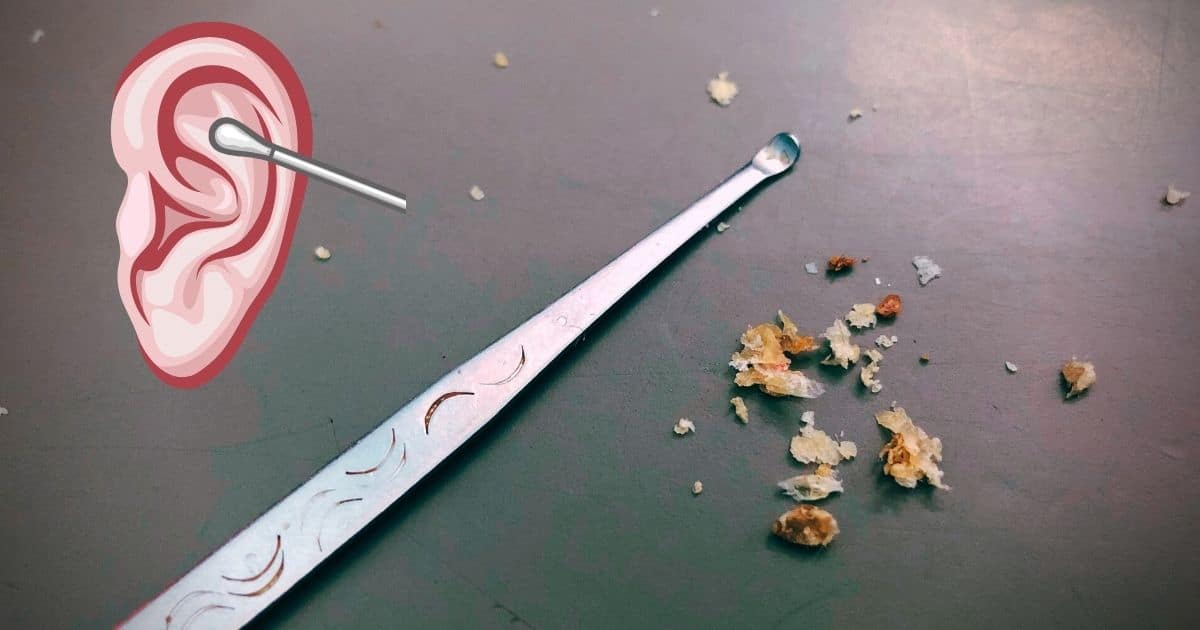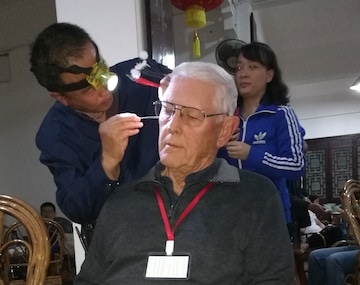A few years ago, a trip to the city of Chengdu, China (home of the giant panda), provided an unexpected experience – the practice of ear-picking, or what some might refer to as ear cleaning or ear scraping.
Ear Picking and Giant Pandas – Chengdu, China
Most tourists who travel to Chengdu, China go to see the giant pandas. However, another attraction is the traditional teahouse. Traditional teahouses have largely disappeared in most of China, but they are still a thriving part of life in Chengdu, considered the city of leisure in China. On nice days, you will find people sitting in teahouses, parks and along the rivers, whiling away the day sipping tea, playing chess, visiting with friends, or just snoozing. But, you will also find some individuals of a special profession roaming around carrying a set of weird instruments – the ear-pickers, as they are called. For many Chinese, teahouses are the perfect place to get your ears cleaned while sipping tea (Figure 1). Every day, hundreds of residents and tourists in the city go to visit ear-cleaning masters, who usually provide their service in tea houses and parks.

Figure 1. In Chengdu, China, you get to pick. Teahouses are a perfect place to get your ears cleaned by ear-pickers, while sipping tea. Or, you can have the giant pandas entertain you. Actually, you can do both.
Ear cleaning is not just a hygiene issue in Asian countries, it is an important part of Asian history and culture. It is a social procedure often performed by friends or loved ones, and usually in the home. Our young female guide of 27 indicated that ear picking was a part of her normal life, as it is for many others. In fact, many Chinese believe that regular ear cleaning is one of the three traditional practices – along with bathing and foot massaging – to help people live a long and healthy life.
Ears and Senses
Ear pickers claim that acupuncture points along with nerve endings in your ears correspond to the internal organs of the body, and that earwax removal with Asian tools can be a soothing and stimulating experience. They claim that it relaxes people’s nerves and makes them feel comfortable. The ear-picking process is often described as an ‘ear massage’ in China as the movements of the tool stimulate acupressure points inside the customers’ ears.
Ear-Picking is Alive and Well in Chengdu
This ancient practice of ear-picking is dying, but is alive and well in Chengdu, capital of Sichuan Province of southwestern China, where the process is considered by many as an enjoyment – thanks to the city’s professional ear-pickers. It is especially a popular pastime in the People’s Park in central Chengdu, and the charge for the service is about 10 yuan (about $1.50 US) and takes about 15 minutes. Ear-picking was originally just one of the services offered by Sichuan’s itinerant barbers, who you still see occasionally on the streets of Chengdu, but it’s now mostly a specialist trade.
Tools of the Trade
Traditional ear-pickers are said to use up to eight tools, including wires, copper tongs, goose down, and wooden scoops, many of these self-made (Figure 2). They also wear headlights while working to help them see better. Figure 3 shows some of the tools up close.

Figure 2. Traditional ear-pickers use up to eight tools, including wires, copper tongs, goose down, and wooden scoops, many of the tools being self-made. The tools are all held in one hand, that bracing against the head. I am not certain what the Exacto blade is used for, but was held by our ear-picker. The headlamp light is washing out the tool being used in the ear canal in the right image.

Figure 3. Some of the tools used for ear-picking. The long object held in the right hand is a tuning fork and comes into play at the end of the session.
While many tools can be used, the traditional ear cleaning tool is the ear pick (being used but with the end not not shown in the photographs because it is in the ear canal). This is a small spoon-shaped instrument used to remove earwax, not unlike a cerumen spoon used by otolaryngologists. Another tool includes an ear hair cutter to trim long hair at the opening of the ear canal or on the lobule. A down puff is used as the final touch – rotated as it sweeps the ear’s surfaces clean. What is surprising is the distance from the head that the tools are held for wax removal. One might assume that his is because if the hand were closer to the ear, the light from the headlights used would be blocked.
Ear-Picking Procedure
The ear-picker uses an eight-instrument technique.
- The skin around the ear is stroked with a small blunt knife, intending to send shivers of pleasure all over the body.
- A thin file is run along the ear lobe and outer edges of the ear canal to remove hair.
- A thinner file, consisting of a flexible metal strip, is used to gently loosen the wax.
- Larger pieces of wax that come loose easily are removed with a pair of pincers.
- Smaller pieces of wax are scraped out using a bamboo stick with a small scoop at the end.
- Down feather brushes were twirled around in the ear canal to remove any wax flakes.
From this point onward, it appears that what follows is more icing on the cake, intending to provide some kind of pleasurable sensation in the ear.
- A hair-thin piece of wire is slid into the ear canal and is tapped around.
- Then a thicker piece of wire, having a loop at the end, is also tapped around in the ear canal.
- A metal rod or bamboo stick with down feathers is inserted, and a tuning fork is gently snapped against the rod, causing the feathers to vibrate inside the canal.
Ear-Pickers are said to have nearly two years of training, much of which involves practicing holding their instruments without twitching or shaking. For some, this involves holding a pair of chopsticks for six hours a day.
Warning
The ear pick is an effective tool for removing the dry, flaky wax common to East Asians. It is not as effective on the tougher wet wax common to those of European and African descent. People with gooey cerumen-laden wax should use irrigation or have a hearing health professional remove the wax.
The art of ear cleaning is extremely delicate as incorrect pressure or angles could cause damage to the customers’ ear canal and/or hearing. The job requires full attention to avoid damage to the customer.
Although the thought of ear-picking can be scary, the experience is apparently enjoyable because it has grown to be one of Chengdu residents’ favorite leisure activities in the past two decades. There is an effort being made by a group of ear-pickers in Chengdu to help preserve their skills so that the time-honored trade can carry on benefiting many Chinese generations to come. Unfortunately, difficult training of the trade has deterred many young generations from entering into this practice. Additionally, more glamorous and profitable industries are preferred by Chinese youngsters.
Note: This article is not a recommendation for ear-picking.
Personal Experience
Having a background in new, and often unusual product development, I have been known to have been involved as a subject so that I can experience first-hand different products/practices. This was no different, so I volunteered to have my ears picked. Actually, I volunteered a couple of days earlier, but did not know what it was for – and volunteering was performed in military style: you and you. I was one of those selected. So, my “volunteering” for ear-picking was a total surprise, and before I had time to think, I was in the bamboo chair in the middle of a Chinese teahouse to have my ears picked, or scraped (Figure 4). And, all we were doing was walking through the teahouse.
I was curious, but somewhat hesitant when I saw the parcel of tools to be used. They all looked as if they would have an unimpeded route from one ear to the other. Instrument disinfecting was identified by a small plastic vile of clear fluid and a piece of cotton taken from a cigarette packet in the shirt pocket. I could only assume that the vial held alcohol or cigarette lighter fluid. Having been in China for almost two weeks at the time, either was OK since my hygiene standards had already been lowered.
I am used to having objects in my ear, including those for cerumen (wax) management, which I frequently perform. There was no discomfort in the procedure used on me, but I had minimum earwax and it had not affixed itself to the canal walls. Still, I could feel a gentle nudging along the edges to loosen what was there, but no discomfort. The artisan probed and scraped inside my ear canal with his scoops, copper prongs, and twirled around inside with a series of down brushes, removing a small amount of wax. Actually, the twirling of the feather down brushes felt good. However, the most intriguing sensations occurred when he placed a tool in my ear and then touched its handle several times with a humming tuning fork of very low frequency. It felt rather good. Not exactly orgasmic, but nice.
Wayne Staab, PhD, is an internationally recognized authority in hearing aids. As President of Dr. Wayne J. Staab and Associates, he is engaged in consulting, research, development, manufacturing, education, and marketing projects related to hearing. His professional career has included University teaching, hearing clinic work, hearing aid company management and sales, and extensive work with engineering in developing and bringing new technology and products to the discipline of hearing. This varied background allows him to couple manufacturing and business with the science of acoustics to bring innovative developments and insights to our discipline. Dr. Staab has authored numerous books, chapters, and articles related to hearing aids and their fitting, and is an internationally-requested presenter. He is a past President and past Executive Director of the American Auditory Society and a retired Fellow of the International Collegium of Rehabilitative Audiology.
**this piece has been updated for clarity. It originally published on October 24, 2017







